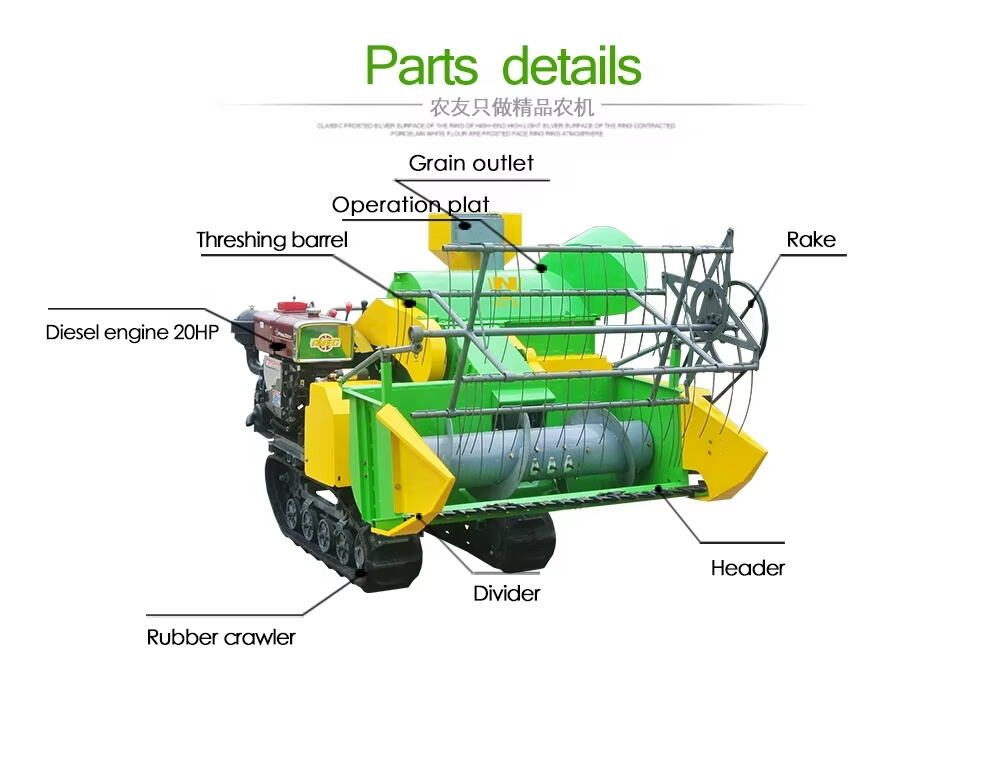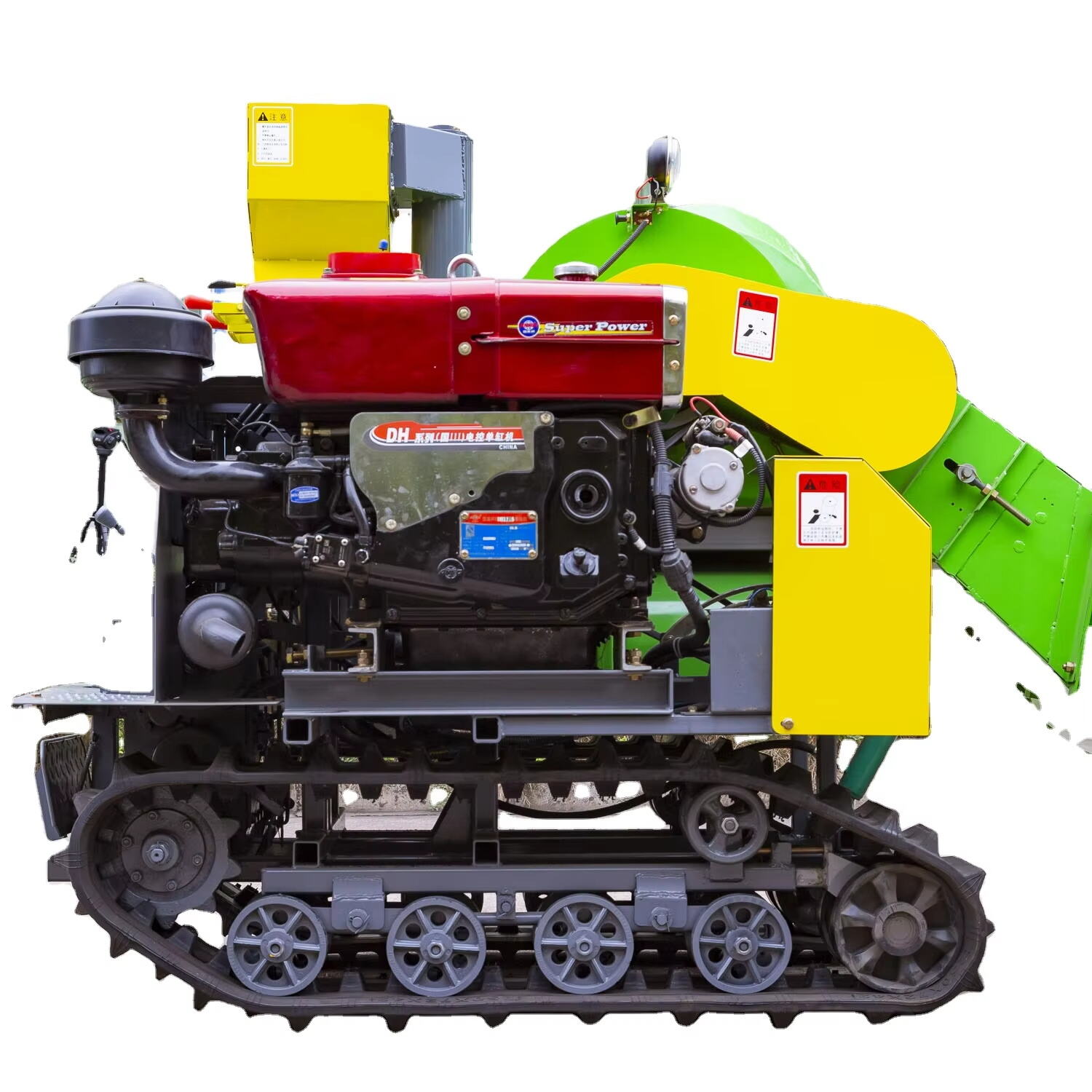अन्नबालीको आधुनिकिकरण: विकसित प्रविधिहरूको एक सिंहावलोकन
किसानहरूले अन्नबाली काट्ने तरिका धेरै वर्षदेखि परिवर्तन भएको छ। जब परम्परागत फसल विधिहरू कुनै समय कृषि उत्पादकत्वको मेरुदण्ड थिए, आधुनिक मेसिनरीहरू जस्तै संयुक्त हार्वेस्टर प्रक्रियालाई पुनः परिभाषित गरेको छ । कम्बाइन हार्वेस्टर टेक्नोलोजी र परम्परागत प्रविधिहरू बीचको भिन्नता बुझ्दा कुन दृष्टिकोणले आजको कृषि मागहरूको लागि राम्रो दक्षता, लागत प्रभावकारिता र स्थिरता प्रदान गर्दछ भनेर स्पष्ट पार्न मद्दत गर्दछ।
कम्बाइन हार्वेस्टरहरूद्वारा दक्षता वृद्धि
समय र श्रम बचत
[पृष्ठ २-मा भएको चित्र] [पृष्ठ २-मा भएको चित्र] कामदारहरूको शारीरिक क्षति धेरै हुन सक्छ, अक्सर फसलको गति र मात्रा सीमित गर्दछ। साथै, म्यानुअल विधिहरू कामदारहरूको सीप र सहनशीलतामा भिन्नताका अधीनमा छन्, जसले समग्र उत्पादकतालाई असर गर्न सक्छ।
यसको विपरित, एक संयुक्त हार्वेस्टर यो एक एकल, निरन्तर कार्यमा धेरै कार्यहरूकट्ने, थ्रेसिङ र शुद्धिकरण अन्नएकताबद्ध गर्दछ। यो मेकानिसनले बाली काट्नको लागि आवश्यक समयलाई निकै कम गर्छ र हातले काम गर्नेलाई कम गर्छ। मौसम परिवर्तन वा कीरा आक्रमणका कारण हुने क्षतिलाई कम गर्नका लागि किसानहरूले छोटो समयमा ठूलो क्षेत्रफलमा खेती गर्न सक्छन्। यसबाहेक, श्रम मागमा कमीले अन्य आवश्यक कृषि गतिविधिहरूको लागि श्रमशक्ति स्रोतहरू स्वतन्त्र बनाउँछ।
फसलको गुणस्तर सुधारियो
कम्बाइनमा एकीकृत थ्रेसिङ र छुट्टयाउने प्रणालीले न्यूनतम क्षतिका साथ सफा अन्न प्रदान गर्दछ। अर्कोतर्फ, परम्परागत विधिहरूले अन्नको अधिक ब्रेकडाउन वा खसीबाट अनाजको अपूर्ण पृथक्करणको कारण हुन सक्छ, जसले मात्रा र गुणस्तर दुवैलाई नकारात्मक असर पार्छ। हातले फसल काट्ने वा प्रारम्भिक थ्रेसिङको समयमा क्षतिग्रस्त अन्नले अक्सर बजार मूल्य कम हुन्छ र पछि लाग्ने बीउको जीवनशैली कम हुन्छ।
आधुनिक कम्बाइनमा विशेष फसल र आर्द्रताको स्तरको आधारमा दानाको खानीको तीव्रता, सफाई संयन्त्र र ह्यान्डलिंग अनुकूलन गर्न समायोज्य सेटिङहरू छन्। यो लचिलोपनले विभिन्न परिस्थितिमा इष्टतम प्रदर्शन सुनिश्चित गर्दछ, फसल उत्पादनको गुणस्तर सुधार गर्दछ। यसबाहेक, केही कम्बाइनहरूमा सेन्सर र स्वचालित सुविधाहरू छन् जसले वास्तविक समयमा अन्नको क्षति अनुगमन गर्दछ, जसले अपरेटरहरूलाई उत्पादनलाई अनुकूलन गर्न तत्काल समायोजन गर्न अनुमति दिन्छ।
विभिन्न विधिहरूको लागि लागत विचार
प्रारम्भिक लगानी बनाम परिचालन लागत
कम्बाइन र परम्परागत फसल काट्ने विधिहरू बीच निर्णय गर्दा एउटा मुख्य विचार लागत हो। परम्परागत फसल काट्ने उपकरणहरू जस्तै खोर वा साधारण थ्रेसिङ मेशिनहरूले कम सुरुवाती लगानीको आवश्यकता पर्दछ, जसले तिनीहरूलाई साना किसानहरू वा सीमित पूंजी भएकाहरूको लागि पहुँचयोग्य बनाउँछ। तर, यी कम सुरुवाती लागतले प्रायः उच्च श्रम लागत र लामो फसल अवधिमा अनुवाद गर्दछ, जसले सम्पूर्ण खेती चक्रलाई ढिलाइ गर्न सक्छ र समग्र दक्षता कम गर्न सक्छ।
यसको विपरीत, एक कम्बाइनमा लगानीले मेसिनको लागत, ईन्धन र मर्मतसम्भार सहित महत्त्वपूर्ण अग्रिम खर्चको प्रतिनिधित्व गर्दछ। तर, दक्षता बढ्दै गएपछि र श्रम आवश्यकता कम हुँदै गएपछि, समयसँगै सुरुमा लाग्ने खर्चको सन्तुलन हुन्छ। मध्यमदेखि ठूलो परिमाणका कार्यका लागि, कम्बाइनको प्रयोगले फसल काट्ने समय छोटो पार्न र अन्नको गुणस्तर सुधार गरेर लाभप्रदतामा उल्लेखनीय वृद्धि गर्न सक्छ।
मर्मतसम्भार र मर्मतसम्भारका प्रभावहरू
परम्परागत फसल काट्ने औजारको मर्मतसम्भार सामान्यतया सरल हुन्छ, जसमा सफा गर्ने, तीखो पार्ने वा ब्लेड वा बेल्ट जस्ता भागहरू बदल्ने काम समावेश हुन्छ। यी मर्मतका कार्यहरूमा सामान्यतया न्यूनतम प्राविधिक विशेषज्ञता आवश्यक हुन्छ र कम लागतमा गरिन्छ, त्यसैले धेरै ग्रामीण क्षेत्रमा परम्परागत औजारहरू व्यवहार्य रहन्छन्।
[पृष्ठ २-मा भएको चित्र] खरिदको समयमा समस्या नआओस् भनेर खरिद गर्ने ड्रम, सिट र हाइड्रोलिक प्रणाली जस्ता सामानहरू नियमित जाँच गर्नुपर्छ। यद्यपि कम्बाइनको मर्मत लागत उच्च छ, तर यसलाई बेवास्ता गर्दा महँगो मर्मत र डाउनटाइमको परिणाम हुन सक्छ, जसले फसलको नतिजालाई गम्भीर रूपमा असर गर्न सक्छ। धेरै आधुनिक कम्बाइनमा परीक्षण उपकरण र मर्मत सम्बन्धी चेतावनी हुन्छ जसले मर्मतसम्भारलाई सरल बनाउँछ र मेसिनको जीवन लम्ब्याउँछ।

वातावरणीय र दिगोपन प्रभाव
ईन्धन खपत र उत्सर्जन
कम्बाइन हर्भेस्टरहरू सामान्यतया डीजल इञ्जिनहरूमा चल्दछन्, जसले ईन्धन खपत र ग्रीनहाउस ग्यास उत्सर्जनको बारेमा चिन्ता उत्पन्न गर्दछ। तर प्राविधिक प्रगतिले इन्धनको खपत कम गर्ने इन्जिन र उत्सर्जन नियन्त्रण प्रणालीहरू बनाएको छ। आधुनिक कम्बाइनहरूले तिनीहरूको वातावरणीय पदचिह्न कम गर्न Tier-4 अनुरूप इञ्जिनहरू वा हाइब्रिड पावरट्रेनहरू समावेश गर्न सक्दछन्।
परम्परागत फसल विधिहरू, प्रायः मानव वा पशु शक्तिमा निर्भर गर्दछ, स्वाभाविक रूपमा कम कार्बन उत्सर्जन गर्दछ तर स्केलेबिलिटी चुनौतीहरूको सामना गर्दछ। ठूलो परिमाणको कृषिमा, हातले फसल काट्नु व्यावहारिक छैन र खाद्य उत्पादनको माग पूरा गर्न पर्याप्त छैन। कृषि क्षेत्रका लागि मेकानिकीकरणका लाभहरू र दिगो अभ्यासहरू बीचको सन्तुलन एउटा महत्वपूर्ण चुनौती रहन्छ।
माटो र बालीको अवशेष व्यवस्थापन
कम्बाइनको एक पर्यावरणीय फाइदा भनेको तिनीहरूको क्षमता हो फसलको अवशेषलाई कुशलतापूर्वक व्यवस्थापन गर्न। धेरै जसो कम्बाइनहरूले कामदारहरूलाई पराल र घाँस कसरी काट्ने र खेतमा कसरी फैलाउने भनेर नियन्त्रण गर्न अनुमति दिन्छ। उचित अवशेष वितरण माटोको सतहको सुरक्षा, कटान कम गर्ने र जैविक पदार्थको पुनर्चक्रणलाई बढावा दिँदै माटोको स्वास्थ्य कायम गर्न महत्वपूर्ण छ।
परम्परागत फसल काट्ने विधिले असमान अवशेषको ढेर छोड्न सक्छ वा अवशेष व्यवस्थापन गर्न थप हातले काम गर्न आवश्यक पर्दछ, जसले माटो संरक्षणको प्रयासलाई बाधा पुर्याउन सक्छ। समायोज्य अवशेष प्रणालीको साथ कम्बाइन कम्पाइनेटरहरूको प्रयोगले समयको साथ माटोको उर्वरता बढाउने कभर फसल र न-उर्वर अभ्यासहरू सक्षम गरेर दिगो खेतीलाई समर्थन गर्दछ।
विभिन्न कृषि परिवेशमा प्रयोग र अनुकूलन
सानो बनाम ठूलो फार्महरूको लागि उपयुक्तता
परम्परागत फसल काट्ने विधि र कम्बाइनमा निर्णय गर्दा खेतीको परिमाणले महत्त्वपूर्ण भूमिका खेल्छ। साना-सानो फार्महरू प्रायः आधुनिक मेसिनरी प्राप्त गर्न वित्तीय र रसद बाधाहरूको सामना गर्दछन्, त्यसैले परम्परागत विधिहरू यी सन्दर्भहरूमा अधिक व्यवहार्य हुन सक्छ। साथै, जसमा इलाका असभ्य छ वा खेतहरू टुक्रा टुक्रा छन्, साना-ठूला परिचालनहरू लचिलोपन र कम पूंजी आवश्यकताहरू हात वा पशु-संचालित फसलको फाइदा लिन सक्छन्।
अर्कोतर्फ, कम्बाइनहरू ठूलो, आसन्न खेतहरूको लागि अनुकूलित छन् र उच्च उत्पादकता र छिटो टर्नअराउन्डको लक्ष्य राख्ने व्यावसायिक फार्महरूको लागि उत्तम उपयुक्त छन्। मौसमको अस्थिरताले गर्दा फसल छिटो काट्न सकिन्छ।
खेतीका प्रकार र भूभागसँग लचिलोपन
आधुनिक कम्बाइनमा विभिन्न प्रकारका सामानहरू र समायोज्य सेटिङहरू छन् जसले विभिन्न प्रकारका बालीहरू जस्तै गहुँ, मकै, सोयाबीन, चावल र जौलाई समायोजन गर्न सक्छ। यो बहुमुखी प्रतिभाले विभिन्न कृषि क्षेत्रमा तिनीहरूलाई अपरिहार्य उपकरण बनाउँछ। अपरेटरहरूले फसल र खेतको अवस्थाको आधारमा फसल काट्ने प्रदर्शनलाई अनुकूलन गर्न हेडर, थ्रेसिङ ड्रम गति, र सफाई प्रणाली परिमार्जन गर्न सक्छन्।
परम्परागत फसल काट्ने विधिहरू कम अनुकूलन योग्य छन् र विभिन्न बालीका लागि फरक उपकरण वा म्यानुअल समायोजन आवश्यक छ, जुन श्रम-गहन र कम कुशल हुन सक्छ। यसबाहेक, कम्बाइनहरू असमान भूभाग र गीला क्षेत्रको अवस्थासँग सामना गर्न बढ्दो रूपमा डिजाइन गरिएको छ, उन्नत कर्षण प्रणाली र फ्लोटेशन टायरले माटोको कम्प्याक्टेसन कम गर्दछ र युक्तिशीलता सुधार गर्दछ।
एफएक्यू
कम्बाइन प्रयोग गर्नुको मुख्य फाइदा के हो?
कम्बाइन हर्भेस्टरले एकैपटक काट्ने, बाला पार्ने र सफा गर्ने काम गर्दा समय र श्रममा ठूलो बचत हुन्छ। परम्परागत विधिहरूको तुलनामा यसले अन्नको गुणस्तर सुधार गर्छ र घाटा कम गर्छ।
के आज पनि परम्परागत फसल काट्ने तरिकाहरू सान्दर्भिक छन्?
परम्परागत विधिहरू सानो-स्केल वा सीमित स्रोत खेतीमा महत्त्वपूर्ण रहन्छन्, कम लागत, पहुँचयोग्य विकल्पहरू प्रदान गर्दछ यद्यपि श्रम-गहन र कम कुशल छन्।
परम्परागत औजारको तुलनामा कम्बाइनको मर्मतसम्भारको खर्च कति छ?
कम्बाइनमा उच्च रखरखाव आवश्यकता र लागत हुन्छ किनभने तिनीहरू जटिल हुन्छन् तर उच्च उत्पादकता प्रदान गर्दछ जुन प्रायः यी खर्चहरू उचित गर्दछ।
के विभिन्न प्रकारका बालीका लागि कम्बाइन कम्पेनर्स प्रयोग गर्न सकिन्छ?
"आफ्नो काममा व्यस्त हुनुहोस्"

